#Blackfeet nation
Explore tagged Tumblr posts
Text

Indigenous Miku because I'm Indigenous lol! More representation! by Pina_Bread
nb: the artist has stated in the thread that this Miku is of the Blackfeet Nation!
598 notes
·
View notes
Text

#lily gladstone#actress#native#blackfeet#indigenous#lily#Killers of the Flower Moon#blackfeet nation
168 notes
·
View notes
Photo

#going to the sun road#glacier#glacier national park#mountain#mountains#gttsr#nature#montana#blackfeet nation
7 notes
·
View notes
Photo

Sikimutasi, Black Horse (Caballo Negro) y su esposa, Ichpi Kaki, Rib Woman (Mujer Costilla) de la Nación Siksika (Pies Negros). Archivos provinciales de Alberta, de los fondos de Harry Pollard, P59. Alrededor de 1910.
#blackfootindian#blackfoot tribe#blackfeet nation#blackfoot#blackfeet#natives#native#native american#Native America#Nativo#nativos#nativo americano#nativoamerica#Nativos Americanos#american indian#American Native#nativeamericans#american natives
3 notes
·
View notes
Video
youtube
Chase & Status - Alive (Official Music Video) ft. Jacob Banks
0 notes
Text
highly recommend checking out the source, the rest of the pictures are just as gorgeous as these ones 🥰
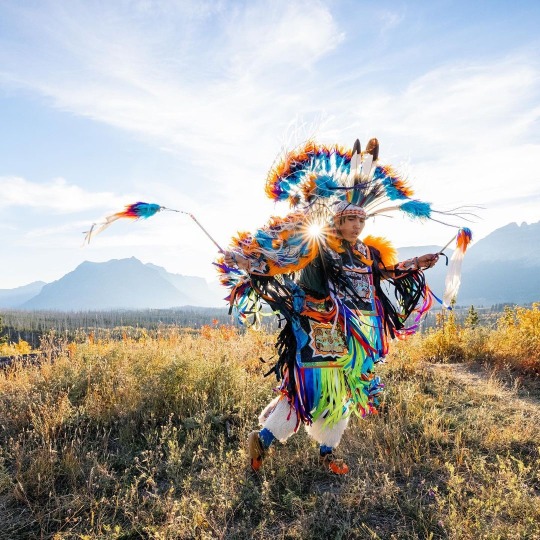


Source: Andy Austin
101 notes
·
View notes
Text
okay, inspired by the “mutuals are you slavic?” post
#if so: where are you indigenous to/what’s your tribal or cultural affiliation??#in this context indigenous does NOT just mean native american#it includes indingeous australians & pacific islanders & first nations people & many others#tumblr polls#polls#indigenous#i’ll go first <3#yes <3#affiliation: cherokee nation & blackfeet nation & eastern band cherokee#(less affiliated with the latter two if i’m being 100% transparent but i do have the heritage… just no living connections anymore)#(also these are native american tribes for those who are unfamiliar <3)
5 notes
·
View notes
Text
At Long Last, The American Buffalo Has Come Home
A conservation effort has returned bison to Blackfeet Nation tribal lands more than a century after the animal was nearly slaughtered to extinction.
— Photographs By Louise Johns | By Lailani Upham | Sunday July 09, 2023
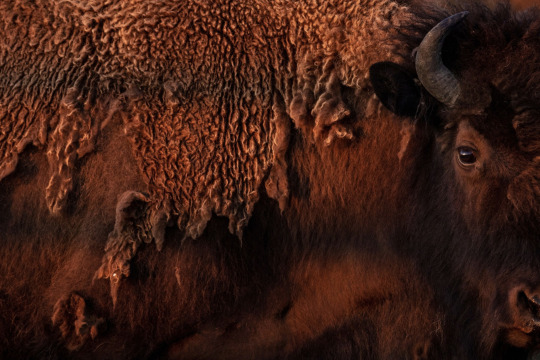
“Nititawahsi” is the Blackfeet name for our land—the land where the iinnii (buffalo) live. Our people are Niitawahsin-nanni: the people of the land where the iinnii live.
As colonizers moved west, millions of buffalo were killed and brought to the edge of extinction. Millions more Native peoples were murdered, displaced, and forced to assimilate. By the end of the 19th century, only 300 buffalo were left in the wild and Native populations dropped to less than 300,000.
Now, after more than 150 years, iinnii have finally returned to their homeland, the Amskapi Pikuni (Blackfeet Nation) tribal lands, to roam free.

Forty-nine buffalo run out of their temporary enclosure towards Chief Mountain on the Blackfeet Reservation. The rest of the herd (about 70 buffalo) will join them at the end of the summer. Chief Mountain is not only prime buffalo habitat, but also a sacred place for Native people in both the U.S. and Canada.
“I can’t hardly describe the feeling that I have. I have this jittery feeling, goosebumps,” says Ervin Carlson, director of the Blackfeet Nation Buffalo Program. “It just feels so good to finally see them here in this place where we want them to be.”
On June 26, 49 iinnii were released into the wild at the base of our sacred Ninaistako (Chief Mountain), a Strong Miistaaki (Mountain) that stands tall like the warbonnets of Blackfeet warriors. This miistaaki towers along the border of the Blackfeet Nation, Glacier National Park in Montana, and Waterton National Park in Canada.
Our people, the Siksikaitsitapi (Blackfoot Confederacy) always believed the land we came from was a gift of the Creator, Ihtsi-pai-tapi-yopa. Our stories tell us that iinnii was created as a gift for our people as our life source. The iinnii were and still are our staff of life.
The iinnii coming back and being free on Blackfoot lands again is the beginning of reconciliation, says Cristina Mormorunni, director of Indigenous Led, the organization that leads cultural restoration and conservation of buffalo on Blackfoot lands. “This is the beginning of the truth being told about what happened, and they’re the best ambassadors,” she says.


Helen Augare, a Blackfeet knowledge keeper and director of the Blackfeet Community College Native Science Field Center, has been an integral voice in the return of buffalo to Chief Mountain for the past 15 years.
Now that the buffalo are free, she says “there’s so much still to reconnect to and learn from them.”
“What does that future look like and what [do] our children and grandchildren need to know to be able to help iinnii live a full and prosperous life with us again?” Augare says. “It entailed everything from healthy people, healthy land, healthy water, and most of all healthy relationships. That in itself requires a lot of healing, growth.”

Buffalo are corralled and sorted (calves from adults, and males from females) at the tribal-owned Buffalo Spirit Hills Ranch on June 25, 2023. The herd, originally from Canada’s Elk Island National Park, have been living on the ranch since 2016. The herd descends from the last remaining wild buffalo before they were nearly extirpated.

Blackfeet tribal member Wyett Wippert takes a photo of his daughter, Ruby, in front of the buffalo in their soft release pen at Chief Mountain. “We put so much of our hearts into getting them here,” he says. “It’s a very good feeling knowing that they are under Chief Mountain. People know what they’re going to be doing for their environment and for us as Blackfeet people.” The buffalo are held here for several hours to settle into their surroundings before being released into the wild.
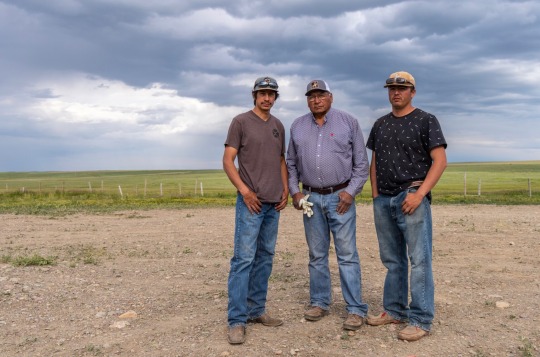
Racine, Monroe, and director Ervin Carlson of the Blackfeet Buffalo Program, on June 25, 2023, after a long day of preparing buffalo to be released at Chief Mountain. “It’s a lot of work to get these animals to this point… they are wild buffalo,” Racine says. “Nobody can do it by themselves. It’s a real honor to be able to have the Iinnii here and to be doing this.”
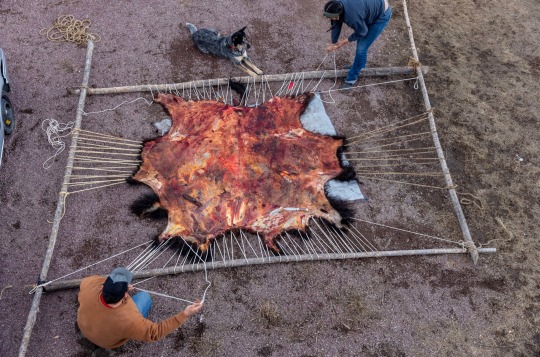
Blackfeet tribal members Wyett Wippert and Christen Falcon work together to stretch their bison hide onto their handmade wooden frame, the first step in tanning the hide by hand at their home in East Glacier, Montana. on April 9, 2023.

“Bison are a keystone species, they are ecosystem drivers and engineers. They were here for thousands of years,” says Brandon Kittson, wildlife biologist for Blackfeet Fish and Wildlife. “Now having them back on this landscape is a good thing. It’s going to help revitalize some systems and help drive diversity among the different vegetation and communities found in this area.”
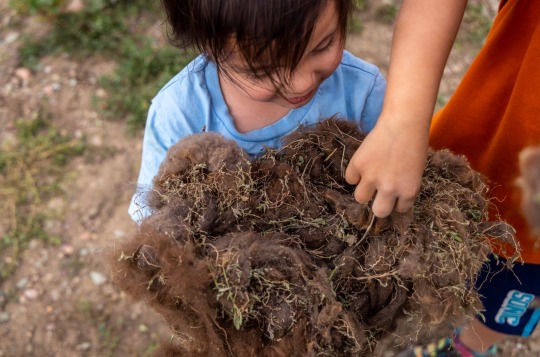
Children collect and examine clumps of buffalo fur from the corral at Buffalo Spirit Hills Ranch on June 25, 2023. The fur is integral to the health of the grassland ecosystem, as certain species of birds use it to line and insulate their nests.
— Photojournalist Louise Johns is a National Geographic Explorer. Her National Geographic Society-funded Project, "Buffalo Renaissance," is about Native American efforts to restore Bison to build cultural resiliency and ecological integrity.
#The National Geographic#American Buffalo#Photojournalist#Louise Johns#Buffalo Renaissance#Amskapi Pikuni (Blackfeet Nation)#Niitawahsin-Nanni#Chief Mountain#Ninaistako (Chief Mountain)#Glacier National Park in Montana#Waterton National Park in Canada#The Siksikaitsitapi (Blackfoot Confederacy)#Cristina Mormorunni#Helen Augare#Montana USA 🇺🇸#Canada 🇨🇦#Brandon Kittson Wildlife Biologist#National Geographic Explorer
32 notes
·
View notes
Text
She Brings Beauty To Me by Karen Kay
A woman deserted. A troubled warrior. A passion denied. Title: She Brings Beauty To Me Series: The Medicine Man Series Book 4 Author: Karen Kay Genre: Historical Native American Romance A woman deserted. A troubled warrior. A passion denied. 1855. When eighteen-year-old Czanna Fehér is forced to flee her home in Hungary, she journeys with her younger siblings and her father’s manservant to…
#Blackfeet Indian Nation#Choctaw Romance Fiction#Historical Native American Romance#She Brings Beauty To Me by Karen Kay#The Medicine Man Series Book 4
0 notes
Text

16 notes
·
View notes
Text
Wikipedia editors push offensive language to delegitimize some Native American Tribes
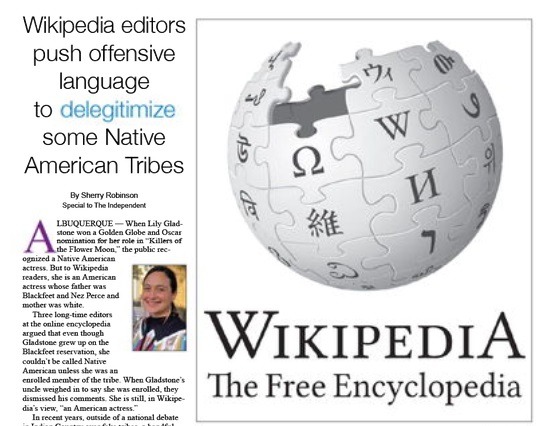





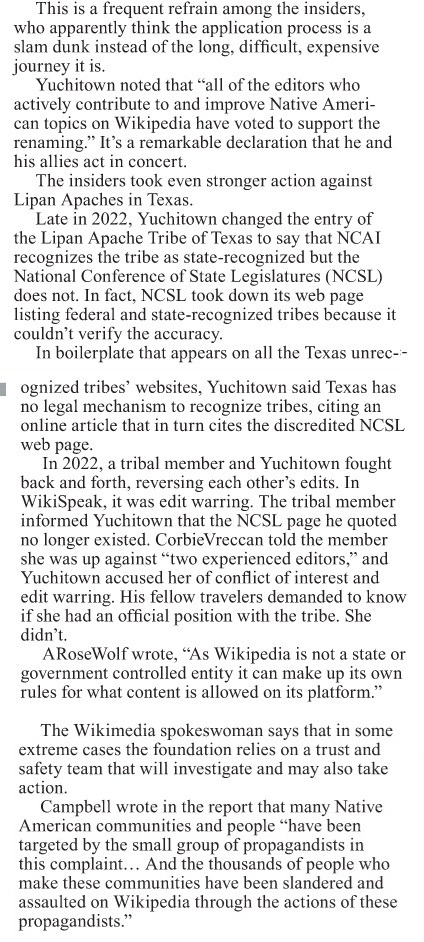
Article Text As Follows:
Wikipedia editors push offensive language to delegitimize some Native American Tribes
By Sherry Robinson
Special to The Independent
ALBUQUERQUE — When Lily Gladstone won a Golden Globe and Oscar nomination for her role in “Killers of the Flower Moon,” the public recognized a Native American actress. But to Wikipedia readers, she is an American actress whose father was Blackfeet and Nez Perce and whose mother was white.
Three long-time editors at the online encyclopedia argued that even though Gladstone grew up on the Blackfeet reservation, she couldn’t be called Native American unless she was an enrolled member of the tribe. When Gladstone’s uncle weighed in to say she was enrolled, they dismissed his comments. She is still, in Wikipedia’s view, “an American actress.”
In recent years, outside of a national debate in Indian Country over fake tribes, a handful of Wikipedia editors have been deciding who is Native American and who isn’t.
Look behind the curtain of the sprawling site and you will find a network of 265,000 volunteer editors writing and editing within a Wiki universe that has its own rules, language, police and courts but no traditional hierarchy.
Wikipedia’s structure allows likeminded editors to work together, but it also permits editors with a bias to advance their agenda. The site has drawn criticism from media and academics for slanted articles on Blacks and Jews. Wikipedia documents its own systemic bias in an article by that name and attributes the problem to too few minority editors. The typical editor, it says, is a white male.
By Wikipedia's definition, the only real tribes are federally recognized; editors of Native American material denigrate state-recognized and unrecognized tribes and seem preoccupied with revealing fake Indians.
The fakes are out there, and they’re a problem. But there’s a big difference between people who invented a Native ancestry and people who have a long, documented heritage.
For this story, aggrieved tribal members didn’t identify themselves because they fear the site’s size and power – it reaches 1.8 billion devices a month – and some editors’ vindictiveness.
Behind the curtain
Wikipedia is transparent about its process. Click on ��talk” at the top of each article and you find the (sometimes endless) debates among editors about an article and see the site’s rules in action.
Editors are anonymous because the Wikipedia Foundation has a strong commitment to privacy, says a spokesperson. However, readers don’t know what expertise editors have or whether they’re Native American.
Editors select their subject matter. With experience they can rise in the pecking order until they gain authority to reverse or eliminate the edits of others. They quote the site’s often arcane rules in Wiki-Speak to anyone who disagrees. While Wikipedia espouses objectivity, neutrality and civility, discussions can take the low road.
On Lily Gladstone’s talk page, a newish editor, user name Tsideh (Apache for bird), asked, “What are your sources supporting the idea that Native Americans are only those who are enrolled in a US recognized tribe?”
A Wiki editor, user name ARoseWolf, answered: “A notable subject can make a claim… but you must have that respective tribal nation’s acceptance as verification through enrollment."
Gladstone’s uncle wrote: “I’m a primary source for Ms. Gladstone’s tribal heritage. Her father is my brother. Through our father, we are both enrolled in the Blackfeet Tribe in the USA,” he wrote. “Our mother is enrolled Nez Perce. So Ms. Gladstone is a direct descendant of both Blackfeet and Nez Perce.”
ARoseWolf shot him down. “We can not use primary sources to verify such information and, you, as a claimed family member have a WP:COI which means we need an independent source.”
WP:COI is the Wikipedia rule on confl ict of interest. Wikipedia forbids primary sources, and yet they’re the gold standard for journalists and academics.
Tsideh challenged the position that only enrollment in a recognized tribe “entitles somebody to claim to be a Native American” as an unfounded, minority point of view that Wiki editors didn’t support with a citation or explanation.
ARoseWolf and others chastised Tsideh for violating Wiki rules on bullying, false accusations and arguing Wiki policy. Tsideh countered that Leonardo DiCaprio didn’t have to prove he was an Italian American, but Lily Gladstone had to prove she was a Native American.
As the back and forth continued, ARoseWolf slammed a new editor who "just happened to find this discussion,” a dig that implies one party enlisted another to join the debate. That too is a Wiki violation.
Bohemian Baltimore, another regular, insisted, “If she’s not enrolled, she may be a descendant, but she’s not a Native American.”
Who is Native American?
Terry Campbell, a Navajo born in Tuba City, Arizona, who lives out of state, has been studying Wikipedia for five months, after friends complained about poor treatment in trying to edit Wiki pages.
One friend wanted to add some facts to an article about a tribe. “These changes were rejected by a handful of editors who cited other Wikipedia pages as sources,” he said, “and I thought that was very, very odd.”
A friend citing sources that prove her tribe survived the Indian wars and received state recognition ran up against Wikipedia guidelines on determining Native American identities that were largely crafted by two editors, user names CorbieVreccan and Yuchitown. Wiki editors used the guidelines to reclassify dozens of state-recognized tribes as “heritage organizations” and removed “Native American” from biographies of prominent tribal members or, worse, called them a "self-identified Native American.”
The implication, Campbell explained, is that the tribe no longer exists and that its members are suspect or even “Pretendians.” Wikipedia has a page for that too.
The same group has shaped many articles on Native subjects. Campbell said he combed through references and found they were misrepresented, taken out of context, sourced from far-right academics, or unreliable.
“The scope of this issue is huge,” Campbell said. “It permeates all the Native articles I checked.”
Campbell recognized talking points from what he called a far-right movement in Indian Country intent on erasing state-recognized and unrecognized tribes. (New Mexico has no state-recognized tribes and six unrecognized groups or tribes.)
Some Native Americans and Anglos, he said, believe that Indigenous people outside the circle of federal recognition should be considered non-Native. They also want to prevent members of the disenfranchised groups from selling their art, receiving ancestral remains, accessing disaster relief or re-establishing their homeland.
Outside Indian Country, it’s not generally known that U.S. Indigenous groups live within a caste system based on government recognition, with 574 federally recognized tribes on top, dozens of state-recognized tribes second, and several hundred unrecognized tribes last.
In 2021, Yuchitown wrote, “The overwhelming majority of ‘List of unrecognized tribes in the United States’ are completely illegitimate.”
There are many reasons why groups aren’t recognized. Some avoided the reservation. Some lost their recognition during the termination era. Some were broken up and scattered during the Indian Wars. Some went underground, practicing their culture secretly while passing as Hispanic. Many simply stayed put.
When Wikipedia editors claim that “Native American” is a political status conferred by the U.S. government, that an individual can only be called a “descendent” until their tribe is recognized, they push this narrative, Campbell said. It’s a contradiction of federal Indian law and the United Nations Declaration on the Rights of Indigenous Peoples.
According to the U.S. Department of Justice, “As a general principle, an Indian is a person who is of some degree Indian blood and is recognized as an Indian by a Tribe and/or the United States. No single federal or tribal criterion establishes a person’s identity as an Indian. Government agencies use differing criteria to determine eligibility for programs and services. Tribes also have varying eligibility criteria for membership.”
Extreme points of view
Campbell has contributed to a lengthy report, as yet unpublished, that identifies biased editors. They include Yuchitown, CorbieVreccan, ARoseWolf, Indigenous girl and Bohemian Baltimore.
“It was like a tree with many interconnecting branches that had been created over time by the same small group of people pushing extreme points of view,” Campbell said.
Initially the group made changes slowly, he said, “but they started pursuing their agenda aggressively after November, when state-recognized tribes retained their voting rights in the National Congress of American Indians (NCAI). Essentially, after the movement to delegitimize state-recognized tribes failed officially, the key players doubled down on altering and controlling the flow of information about Native Americans through Wikipedia.”
Campbell observed widespread violations of Wikipedia standards: “I found evidence that they blatantly misquoted and misrepresented sources to push extremist political beliefs; teamed up to manipulate the consensus system by voting in blocks; exploited Wikipedia rules, such as conflict of interest, to block outside editors from making changes to Native-related pages; excessively cited opinion pieces from fringe political figures, including those accused of racism and anti-semitism; blocked the use of legitimate primary and secondary sources that contradict their extremists beliefs, which violates Wikipedia’s rule against information suppression; posted originally researched, politically motivated essays instead of well-sourced articles; and harassed and defamed Native American tribes and living Native American people.”
Reacting in February to an early draft of the report posted on Google, the editors were incensed that anybody would voice complaints “off-Wiki.” ARoseWolf wrote that “we have been attacked, threatened with legal action and had misinformation/ false claims spread against us.” She and Yuchitown denied being part of a conspiracy against tribes or organizations and said they were just following Wiki rules. Yuchitown accused critics of being “meat puppets” of a person who objected to some Native content and enlisted others to back them up. In WikiSpeak this is meat puppetry.
“Volunteers on Wikipedia vigilantly defend against information that does not meet the site’s requirements,” the Wikipedia spokeswoman wrote. “These volunteers regularly review a feed of real-time edits to quickly address problematic changes; bots spot and revert many common forms of negative behavior on the site; and volunteer administrators (trusted Wikipedia volunteers with advanced permissions to protect Wikipedia) further investigate and address negative behavior. When a user repeatedly violates Wikipedia policies, Wikipedia administrators can take disciplinary action and block them from further editing.”
Inaccurate and insulting
In 2006, Wikipedia established the WikiProject Indigenous Peoples of North America to improve its Native-related content of 14,000 articles and more than 37,000 pages.
Recently, a hot topic on the project’s talk page was a proposal to change a category name from “unrecognized tribes” to “organizations that self-identify.”
On April 15 Melissa Harding Ferretti, chairwoman of the Herring Pond Wampanoag Tribe in Massachusetts, wrote, “The proposed renaming of the category on Wikipedia is not only inaccurate… but also insulting.”
Ferretti is one of the few Natives to take on Wiki editors openly.
Herring Pond was originally listed with other Wampanoag tribes. In 2022 Yuchitown stripped “state-recognized” from the page, even though the state Commission of Indian Affairs regularly engages with them. Last year Yuchitown created a separate page for Herring Pond. Wiki editors resisted attempts to make changes or corrections.
After Wikipedia called Herring Pond a “cultural heritage group" and a nonprofi t that "claims" to descend from Wampanoags, Ferretti wrote in a Wiki discussion, “There is no claim, it’s a fact! Might I add, nonprofit status was imposed upon Tribal nations in the ‘90s because we didn’t have our federal recognition yet.”
Her tribe has a well-documented history. “We still have care and custody of our sacred places, burial grounds and our 1838 Meetinghouse, one of three built for the Tribe after the arrival of the colonizers. Our continuous presence and stewardship of these lands are recognized by historical records, deeds and treaties.”
Ferretti wrote that tribes without federal recognition already face significant hurdles to gain recognition, "and being labeled as 'self-identified' can add to these challenges by casting doubt on our legitimacy.” Mislabeling unrecognized tribes “can lead to the spread of hate, misinformation and further marginalization.”
Some Wiki editors agreed. One wrote that “there are strong negative connotations to saying someone who is Native 'self identifies,' because the inference is that they are Native in name only or falsely claiming to be Native. A change like this will impact countless articles…” Bohemian Baltimore, ARoseWolf and Yuchitown insisted there were no negative connotations. They opposed calling an unrecognized group a tribe because it legitimized groups with unverified claims. ARoseWolf said, “If they had proof of their connection to the original people they would have gotten federal recognition.”
This is a frequent refrain among the insiders, who apparently think the application process is a slam dunk instead of the long, difficult, expensive journey it is.
Yuchitown noted that “all of the editors who actively contribute to and improve Native American topics on Wikipedia have voted to support the renaming.” It’s a remarkable declaration that he and his allies act in concert.
The insiders took even stronger action against Lipan Apaches in Texas.
Late in 2022, Yuchitown changed the entry of the Lipan Apache Tribe of Texas to say that NCAI recognizes the tribe as state-recognized but the National Conference of State Legislatures (NCSL) does not. In fact, NCSL took down its web page listing federal and state-recognized tribes because it couldn’t verify the accuracy.
In boilerplate that appears on all the Texas unrecognized tribes’ websites, Yuchitown said Texas has no legal mechanism to recognize tribes, citing an online article that in turn cites the discredited NCSL web page.
In 2022, a tribal member and Yuchitown fought back and forth, reversing each other’s edits. In WikiSpeak, it was edit warring. The tribal member informed Yuchitown that the NCSL page he quoted no longer existed. CorbieVreccan told the member she was up against “two experienced editors,” and Yuchitown accused her of conflict of interest and edit warring. His fellow travelers demanded to know if she had an official position with the tribe. She didn’t.
ARoseWolf wrote, “As Wikipedia is not a state or government-controlled entity it can make up its own rules for what content is allowed on its platform.”
The Wikimedia spokeswoman says that in some extreme cases the foundation relies on a trust and safety team that will investigate and may also take action.
Campbell wrote in the report that many Native American communities and people “have been targeted by the small group of propagandists in this complaint… And the thousands of people who make these communities have been slandered and assaulted on Wikipedia through the actions of these propagandists.”
Link to the original article:
6K notes
·
View notes
Photo

Grupo de hombres Kainai (Pies Negros) en Winnipeg, Manitoba (Canadá). Año: 1913. Fotografía tomada por 'Lyall Commercial Photography Company' (la Empresa de Fotografía Comercial Lyall). La Empresa de Fotografía Comercial Lyall fue establecida en Winnipeg por el fotógrafo Maurice Lyall (nacido en Escocia, alrededor de 1887 y fallecido en el Hospital General de Winnipeg, el 28 de febrero de 1966).
#blackfootindian#blackfoot#blackfeet#blackfoot tribe#blackfeet nation#natives#native#native american#Native America#Nativo#nativos#nativo americano#nativoamerica#Nativos Americanos#american indian
2 notes
·
View notes
Text
‘Bigger than the Oscars’: Blackfeet Nation honors Lily Gladstone with stand-up headdress
BROWNING — Wearing a white sequin shawl and matching ribbon skirt, esteemed actress Lily Gladstone kneeled on the floor of the new arbor on the Blackfeet Reservation as tribal elders placed a stand-up headdress atop her head.
Thousands of people who traveled across the country — and from Canada — to honor Gladstone watched in silence.
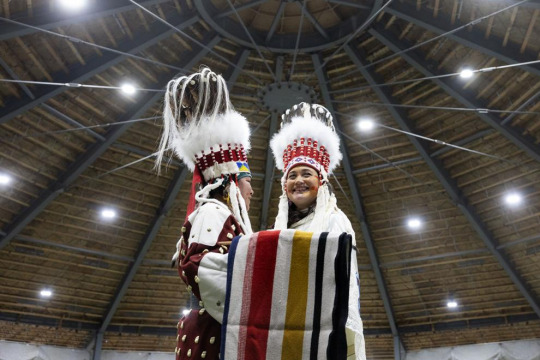
Gladstone stood and embraced tribal leaders. Then, with one hand over her heart and the other holding onto Charlene Plume, the elder who made her headdress, Gladstone danced in a circle around the arbor. Members of the Women’s Stand-Up Headdress Society, tribal leaders, dignitaries, students, teachers and children followed behind.
The sound of drums boomed, and the crowd erupted.
Gladstone, who grew up in Browning and East Glacier, recently rose to worldwide fame after starring in Martin Scorsese’s “Killers of the Flower Moon” alongside Robert De Niro and Leonardo DiCaprio.
She made history, becoming the first Indigenous person to win a Golden Globe award for best actress and the first to be nominated for best actress at the Oscars.
At Tuesday’s event — which included a grand entry, flag song, prayer, speeches from dignitaries, honor song and round dance — leaders thanked Gladstone for representing the Blackfeet Nation on the world stage and for being a role model for young people.

“Because of you, rez kids on every reservation here and in Canada can chase their dreams,” Councilman Everett Armstrong said at the event. “Students, take a look at this accomplishment — it’s possible.”
Councilman Robert DesRosier delighted in the fact that Gladstone “is just like us.”
“She’s us,” he told the crowd before turning to Gladstone. “Lily, welcome home.”

More than 50 members of the Women’s Stand-Up Headdress Society — a group of contemporary Blackfoot women in the U.S. and Canada who own such headdresses — traveled to Browning to celebrate Gladstone. Theda New Breast, a member of the society, said Tuesday marked the largest gathering of stand-up headdress members to date. (BEN ALLAN SMITH, Missoulian)
more at the link
5K notes
·
View notes
Text

I’ve asked Palestinian Americans who have also drawn parallels between themselves and the First Nations Indigenous peoples what exactly they knew about them or their histories. Given that I’m Canadian and my first work clinicals were on Coast Salish reservations it’s a topic close to my heart. I asked them if they knew the differences between First Nations, Métis and Inuit. They didn’t. I asked if they knew about the six nations. They didn’t. I asked if they knew about the the Proclamation of 1763. They didn’t. The Sioux wars? No. Trail of Tears? Nope. They had zero knowledge on any of the nation’s social organization, spiritual beliefs or traditional ways of life. I already know you have no idea about the symbolic meaning of that headdress or that they were worn by Sioux, Blackfeet, Crow, Plains Cree, and Cheyenne people... And I don’t know whether to laugh or cry that he’s been drawn in a grass skirt? (the men wore leggings). Indigeneity is also not a matter of genetics. It’s defined by historical continuity on a specific common place of origin/land. There is a distinct social, economic, linguistic, cultural and political system which predate colonial societies. The differences just within North America are so widespread it’s impossible to draw those kinds of comparisons… I’m begging you to learn the bare minimum about the people and the histories you’re appropriating.
#cultural appropriation#indigenous americans#indigeneity#anti free palestine#listen i do not and will not pretend that i speak for all indigenous americans because i'm not#how-ev-er it's insidious how the palestinian cause has appropriated real peoples' struggles#and again if we're doing indigeneity by 'who was there first'#then the jews are indigenous to the region
97 notes
·
View notes
Text

CHIEF MOUNTAIN, also known as Nínaiistáko in Blackfoot or "Old Chief" in English, is a prominent peak located on the border of the Blackfeet Indian Reservation in Montana, United States, and Alberta, Canada. It is considered one of the most sacred sites for the Blackfeet Nation and holds significant cultural and spiritual importance.
The mountain and its surrounding area are part of the Glacier National Park and Waterton Lakes National Park, jointly designated as the Waterton-Glacier International Peace Park. This designation reflects the cross-border cooperation between the United States and Canada in preserving the natural and cultural heritage of the region, including the sacred significance of the peak to indigenous peoples..
87 notes
·
View notes
Text

Thomas White Calf said “Our ancestor was the most famous and most photographed native in history. Two Guns was also the face on the Indian head nickel. I'm proud of him. The Blackfeet are proud of him." interview with fox news.
25 notes
·
View notes